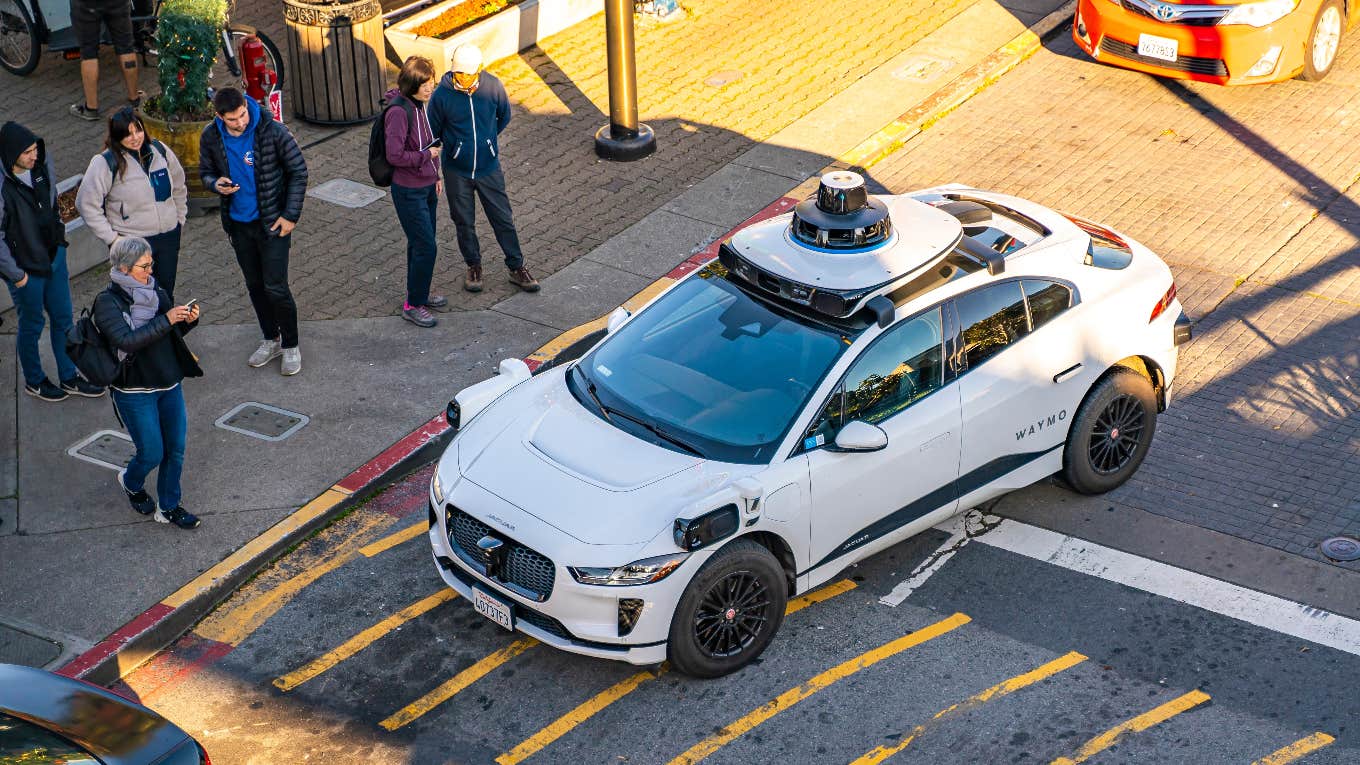Woman Gets Trapped In Driverless Taxi When Catcalling Men Refuse Move Out Of Her Path
The incident has raised serious questions about the safety of AI-powered autonomous cars like Waymo taxis.
 Iv-olga | Shutterstock
Iv-olga | Shutterstock It's one of the most classic lines in "Jurassic Park": "Your scientists were so preoccupied with whether or not they could, they didn't stop to think if they should."
Such seems to be the case with ever more technological advances nowadays, and a San Francisco woman's recent experience with Waymo, Google's self-driving taxi company, is a perfect example.
Her terrifying encounter with sexist men who were able to disable the vehicle is only the latest in a string of incidents that have revealed the Google product's limitations and the dangers they can potentially pose to customers.
The woman was trapped in her Waymo taxi by catcalling men to get her number.
Amina is a social media user and tech worker whose area of expertise—"Human-Computer Interaction & Growth Engineering," according to her X bio—is directly related to the harrowing experience she recently had in a Waymo, the autonomous taxis developed by Google that currently cruise the streets of San Francisco, Los Angeles, Phoenix, and Austin.
In a post on X, Amina shared what happened to her during a recent Waymo trip. She became stranded in the car because a group of catcalling men insisted she give them her phone number.
In her posts, she stressed that she loves the Waymo system and service and will likely continue using it despite the incident. But it's given even a tech professional like her pause and left many others online terrified by what could very easily have escalated to a truly awful situation.
Waymo uses AI-led software to determine their moves. When the men blocked the taxi's path, it seemed to have disabled itself.
According to Waymo, its cars use a combination of incredibly detailed maps, "real-time data" from the cars' litany of sensors, and "artificial intelligence (AI)" to locate itself, navigate city streets, and, most importantly, decide its moves.
This combination of sensors and AI is how autonomous vehicles, for instance, decide to stop rather than hit a person standing in the street. So when a group of sexist men approached Amina's Waymo, it did exactly what it was designed to do — came to a dead stop and refused to move until the men got out of the way.
That resulted in, as her video shows, Amina being essentially trapped — her choices were to stay inside the disabled car or get out and face the men hounding her, both of which seem to have left her terrified as she was heard yelling at the men to move.
She told The San Francisco Standard she was "frightened" by the encounter because she "didn’t know what [the men] were gonna do.” She also said in her X thread that another man was nearby wielding a blowtorch."
Even after the men got out of the way, the car continued to sit in the middle of the street, presumably because it was "confused" by the situation and disabled itself for safety. A message appeared on the screen notifying Amina that Waymo's "team" was working to "get you moving" again.
Waymo autonomous taxis have been involved in several similarly terrifying incidents.
Speaking to The San Francisco Chronicle, Waymo spokesperson Julia Ilina pointed out that incidents like Amina's are "exceedingly rare." Amina says she is satisfied with Waymo's response to the incident and will likely continue using the service.
Still, hers is only one of several high-profile incidents with the company's taxis. Just days before Amina's, a group of women posted footage of their bracing encounter with vandals who stopped their Waymo by sabotaging its sensors and began to deface it with spray paint while hurling objects at the glass. A similar incident went viral earlier this year.
In May, Waymo became the subject of a federal investigation by the National Highway Safety Administration after numerous reports of the autonomous taxis violating traffic rules and getting into crashes. A June crash in Phoenix in which one of the robotaxis drove into a utility pole during a routine pullover maneuver also resulted in a recall of Waymo's software.
Still, Waymo's crash rates are vanishingly small compared to regular cars driven by humans. But it's not easy to shake the central fact of Amina's experience and others' — they were essentially made possible by the cars' technology. Without sensors to block, the car wouldn't have been disabled. A driver behind the wheel is unlikely just to sit there and let catcallers or vandals threaten their vehicle. Amina's situation, indeed, could easily have been so much worse.
Driver-led services like Uber and Lyft come with their own dangers. But as the list of issues with Waymo and the autonomous features onboard Tesla vehicles continues to mount, it's hard not to feel like this technology just isn't quite ready for prime time—and is using real, live human beings as guinea pigs to get there.
John Sundholm is a news and entertainment writer who covers pop culture, social justice, and human interest topics.
